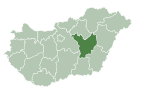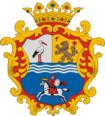Nagykörű
Nagykörű | |
|---|---|
Village | |
|
UTC+2 (CEST) | |
| Postal code | 5065 |
| Area code(s) | (+36) 56 |
Nagykörű is a village in
Location
The village is located on the right bank of River Tisza, 25 kilometres away to the northeast from Szolnok. It can be approached on road by scheduled overland bus from the west, by ferry from the direction of Fegyvernek (from the east), or by bicycle on Tisza-dam.
History
Nagykörű got its name because it was almost completely compassed by Tisza before the river control. The settlement was rising as an isle among the neighboring river meadows. The first written document of Nagykörű monastery derives from year 1212. The village itself was founded at the beginning of the 14th century, and it belonged to the property of Ban Lothar of Gutkeled.
The estate called Kürümonostora was endowed by King

In the middle of 18th century, Nagykörű started to develop spectacularly. The first
Ethnic groups
In 2001, according to the census, 94 percent of the population avowed themselves
The present
Worldwide famous cherry of Nagykörű is considered to be the cost-of-living source of inhabitants. Cherry is principally grown for export. Meanwhile, villageous tourism is also prospering. The ratio of resident population is decreasing, whereas fourth of the houses are used as holiday resorts. The surrounding neighborhood is a real paradise for tourists, line-fishermen, and bathers.
References
External links
- Official site in Hungarian, English and German


